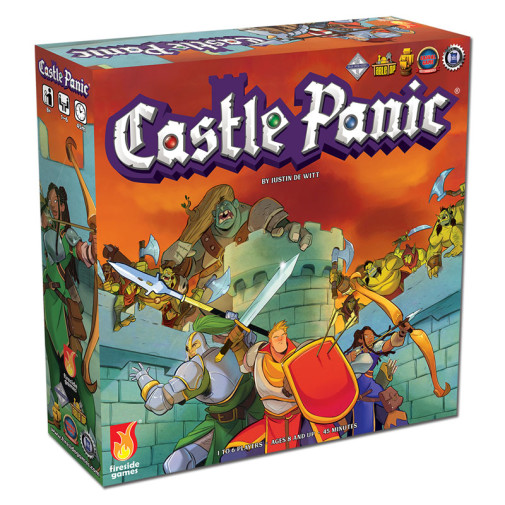We use cookies to make your experience better. To comply with the new e-Privacy directive, we need to ask for your consent to set the cookies. Learn more.
Castle Panic Game (2nd Edition)
Goblins, orcs, and trolls are attacking the castle, and its up to you and your fellow generals to defend it! In the center of the board is a castle with six towers, bordered by six walls. Each wall faces a different 60-degree arc of the board, numbered 1-6 and colored either red, green, or blue. Surrounding the castle are four rings that determine distance from the castle, from closest to furthest: Swordsmen range, Knights range, Archer range, and Forest (which holds monsters and other baddies) range. Each player is dealt 4-6 cards (depending on the number of players). Each turn, players can discard, trade, and play cards. These cards allow players to draw additional cards, rebuild walls, or attack the monsters advancing on the castle. For example, if a goblin was in the green Archer range, a player could use a green archer card to attack it. At the end of each players turn, two things happen: all monsters advance towards the castle, destroying walls or towers if they are close enough, and two extra monster tiles are drawn and placed on the board. And when a special tile is drawn, like the Goblin King, a boulder, or the dreaded draw 4 more monster tiles, its time to panic! The goal is to make it through the entire deck of monsters without losing all of the castle towers.
Once you feel confident enough to fend off the hordes of enemies, you can try upping the difficulty with variantsincluding one that lets a single player become the dungeon overlord and control the monsters. A good amount of strategy and a whole lot of cooperation is key to ensuring your castles survival! The game is quite difficult at times (hence the name!), but can be enjoyed by anyone 8 and up. A perfect family/friends game for 1-6 players. ~ 60 minutes.
Castle Panic Second Edition is the latest version of the hit cooperative tower defense board game for 1 to 6 players. The co-op element makes Castle Panic a great family game and the perfect kick-off for your weekly game night.
You and your friends must work together to defend your Castle, in the center of the board, from Monsters that attack out of the forest, at the edges of the board. Trade cards, hit and slay Monsters, and plan strategies together to keep your Castle towers intact. You either win or lose together, but only the player with the most victory points is declared the Master Slayer.
Castle Panic Second Edition features the same great gameplay as the original game, but with all-new updated art, and a custom die.
Includes:
- Game board
- Rule book
- 1 Die
- 1 Tar token
- 6 Walls
- 6 Towers
- 2 Fortify tokens
- 49 Castle cards
- 49 Monster tokens
- 6 Order of Play cards
- 12 Plastic Stands
Our family has long enjoyed playing co-operative games from Family Pastimes. We play competitive ones, too, but enjoy fostering team spirit as we all work toward achieving a goal. If you haven't tried this alternative to playing together, here's an assortment of some of our favorites from this company.
| Product Format: | Other |
|---|---|
| Brand: | Fireside Games |
| Grades: | 5-AD |
| EAN/UPC: | 850680002357 |
| Length in Inches: | 10.5 |
| Width in Inches: | 10.5 |
| Height in Inches: | 2.5 |
| Weight in Pounds: | 2.25 |

